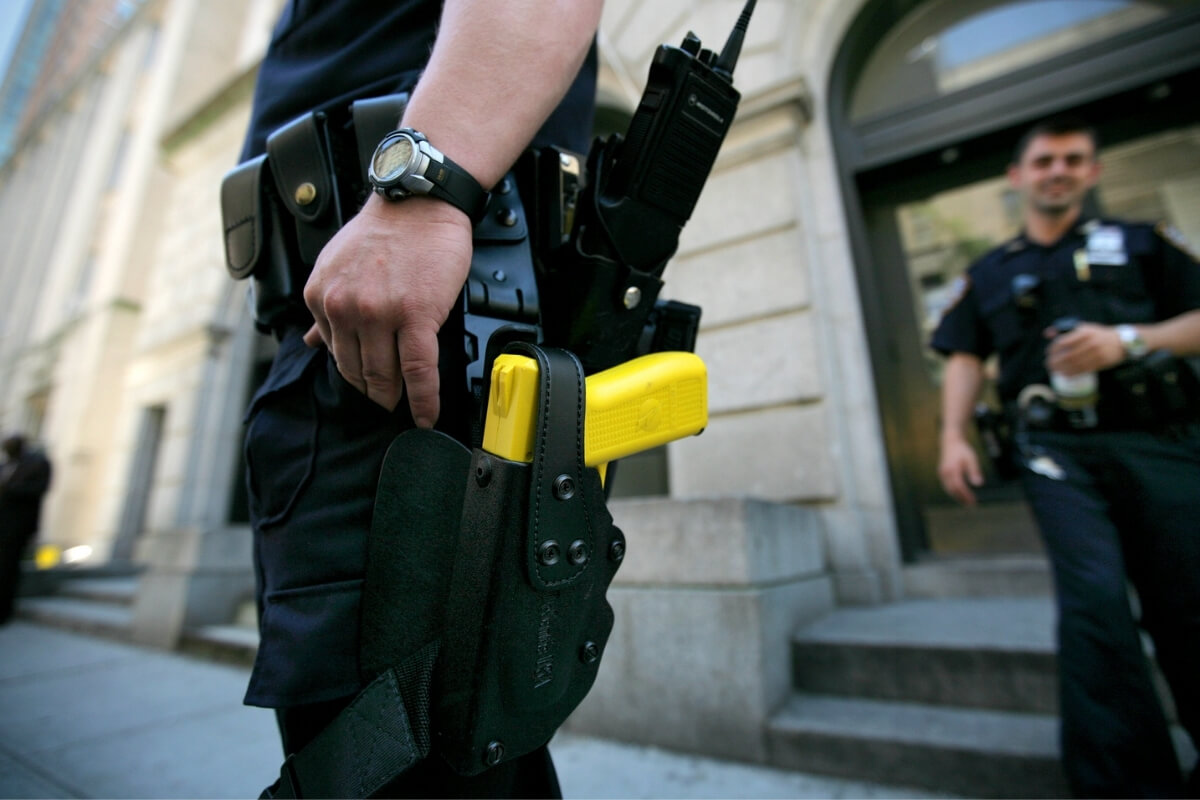How Many Volts is a Police Taser? The Truth

Police tasers pack a powerful punch, delivering up to 50,000 volts to incapacitate suspects. But there’s more to the story than just this eye-catching number.
Tasers have become a common tool for law enforcement, offering a less-lethal alternative to firearms. But many people wonder about the voltage these devices use and how they really work. This guide digs into the facts about police taser voltage, separating myth from reality.
We’ll explore how tasers function, their actual voltage output, safety considerations, and the impact of these devices on modern policing. Whether you’re curious about law enforcement tools or concerned about public safety, this article aims to provide clear, factual information about police tasers and their voltage.
Introduction to Police Tasers
What is a Police Taser?
A police taser is a handheld device that fires two small dart-like electrodes. These electrodes stay connected to the main unit by thin wires. When the darts hit a target, they deliver an electric shock that disrupts muscle function. This causes temporary incapacitation, allowing officers to subdue a suspect without resorting to lethal force.
Tasers are classified as “conducted energy weapons” or “electronic control devices.” They’re designed to be a safer alternative to traditional firearms, reducing the risk of fatal injuries during police encounters.
Brief History of Tasers in Law Enforcement
Tasers first entered the law enforcement scene in the 1990s. Jack Cover, a NASA researcher, invented the original taser in the 1970s. He named it after a fictional weapon in one of his favorite childhood books.
Initially, tasers saw limited use due to reliability issues and concerns about their effects. However, advancements in technology led to improved models in the late 1990s and early 2000s. These newer versions quickly gained popularity among police departments across the United States and beyond.
Today, tasers are standard equipment for many law enforcement agencies worldwide. They’ve become a crucial tool in the spectrum of force options available to police officers.
Understanding Taser Voltage
The Basics of Electrical Voltage
Before diving into taser specifics, let’s clarify what voltage actually means. Voltage is a measure of electrical potential difference. It’s the force that pushes electrons through a circuit. Think of it like water pressure in a pipe – the higher the voltage, the more potential energy the electricity has.
However, voltage alone doesn’t determine how dangerous an electrical current is. The amount of current (measured in amperes) and the duration of exposure also play crucial roles. This distinction is key to understanding taser effects and safety.
Voltage in Police Tasers: Breaking Down the Numbers
Police tasers typically generate a peak voltage of about 50,000 volts. This high voltage allows the electricity to arc through air and penetrate clothing. However, the voltage that actually enters the body is much lower.
When taser probes make contact with a person, the voltage drops significantly. The actual voltage delivered to the target is closer to 1,200 volts. This lower voltage is still enough to cause muscle contractions and temporary incapacitation.
It’s important to note that the high initial voltage isn’t what makes tasers effective. Rather, it’s the combination of voltage, current, and pulse duration that creates the incapacitating effect.
Police Taser Voltage: Myth vs. Reality
Common Misconceptions About Taser Voltage
Many people believe that tasers deliver a continuous 50,000-volt shock to the body. This misconception has led to fears about the safety of these devices. In reality, the 50,000 volts only occur in the brief moment when the electricity arcs from the taser to the target.
Another myth is that higher voltage always means more danger or pain. While voltage contributes to a taser’s effectiveness, it’s not the only factor. The amount of current and how it’s delivered play equally important roles.
Actual Voltage Output of Police Tasers
The truth about taser voltage is more nuanced than the headlines suggest. Here are the key points:
- Initial arc: Up to 50,000 volts
- Voltage on body contact: Around 1,200 volts
- Current: Approximately 2.1 milliamps
- Pulse duration: About 100 microseconds
These numbers show that while the peak voltage is high, the actual electrical energy delivered to the body is relatively low. It’s designed to be enough to cause muscle incapacitation without causing lasting harm under normal circumstances.
How Police Tasers Work
The Mechanism Behind Taser Technology
Police tasers use a technology called “neuromuscular incapacitation” (NMI). Here’s a step-by-step breakdown of how they work:
- Firing: When triggered, the taser fires two small probes attached to thin wires.
- Contact: The probes penetrate clothing and stick to the skin or close to it.
- Circuit completion: An electrical circuit forms between the two probes.
- Pulse delivery: The taser sends rapid electrical pulses along the wires.
- Muscle disruption: These pulses interfere with the body’s neuromuscular signals.
- Incapacitation: The target loses voluntary muscle control, often falling to the ground.
This process happens in a split second, making tasers effective for quickly subduing uncooperative suspects.
Taser Probes and Electrical Current
The taser’s probes are crucial to its function. They’re designed to penetrate light clothing and stick to the skin. The further apart the probes land, the more muscle groups are affected.
The electrical current travels between the probes, creating a circuit through the target’s body. This current is what causes the muscle contractions. It’s important to note that the current, not the voltage, is the key factor in the taser’s effects.
Most police tasers deliver their charge in 5-second cycles. Officers can extend this duration if needed, but prolonged exposure increases the risk of injury.
Factors Affecting Taser Effectiveness
Distance and Probe Spread
The effectiveness of a police taser depends heavily on two factors: the distance from which it’s fired and how far apart the probes land on the target.
Most police tasers are effective from up to 15 feet away. Beyond this range, accuracy decreases and the probes may not have enough momentum to penetrate clothing.
The spread between the probes is also crucial. A wider spread affects more muscle groups, increasing the taser’s effectiveness. At close range, the spread is smaller, which can reduce the taser’s impact.
Clothing and Skin Contact
Thick or loose clothing can interfere with a taser’s effectiveness. The probes need to either make direct skin contact or get close enough to allow the electricity to arc to the skin.
Heavy winter coats, leather jackets, or multiple layers of clothing can sometimes prevent the probes from making proper contact. In these cases, the taser may not work as intended.
Taser Models Used by Law Enforcement
Popular Police Taser Models and Their Voltages
Several taser models are commonly used by law enforcement agencies. Here are some popular ones:
- TASER X26P: This model delivers a peak voltage of 50,000 volts. It’s compact and widely used by police departments.
- TASER X2: Featuring a dual-shot capacity, the X2 also delivers up to 50,000 volts. It allows officers to fire a second shot quickly if the first misses.
- TASER 7: The newest model, the TASER 7, uses a different pulse waveform but still operates in the 50,000-volt range.
All these models are designed to deliver similar effects despite minor differences in their specifications.
Comparing Civilian and Law Enforcement Tasers
Civilian tasers generally have lower voltage and range compared to police models. They’re also subject to more legal restrictions. Here are key differences:
- Voltage: Civilian models often have lower peak voltages, typically around 30,000 volts.
- Range: Most civilian tasers have a shorter effective range, usually under 15 feet.
- Features: Law enforcement models often have additional features like data logging and dual-shot capability.
- Availability: Police tasers are not generally available for civilian purchase in most jurisdictions.
It’s crucial to note that in many places, civilian ownership of tasers is heavily regulated or prohibited.
Safety Considerations of Police Tasers
Potential Health Risks and Precautions
While tasers are considered less-lethal weapons, they’re not without risks. Some potential health concerns include:
- Cardiac effects: In rare cases, taser shocks have been associated with cardiac arrhythmias.
- Falls: The sudden loss of muscle control can cause falls, potentially leading to injuries.
- Seizures: There have been reports of taser use triggering seizures in some individuals.
- Psychological impact: Being tased can be a traumatic experience for some people.
To mitigate these risks, police departments have strict guidelines on taser use. These often include avoiding use on vulnerable populations like the elderly, pregnant women, or people with known heart conditions.
Training and Guidelines for Taser Use
Law enforcement agencies provide extensive training on taser use. This typically includes:
- Technical training: Understanding how the device works and its effects.
- Tactical training: Learning when and how to deploy tasers effectively.
- Safety protocols: Guidelines on target areas and situations to avoid.
- First aid: Training on how to care for a person after they’ve been tased.
- De-escalation techniques: Learning how to resolve situations without force when possible.
These training programs aim to ensure that officers use tasers safely and appropriately.
Alternatives to Tasers in Law Enforcement
Other Less-Lethal Weapons
While tasers are popular, they’re not the only less-lethal option available to law enforcement. Other tools include:
- Pepper spray: Causes irritation to eyes and respiratory system.
- Rubber bullets: Less lethal projectiles designed to stun rather than penetrate.
- Batons: Traditional impact weapons for close-quarter control.
- Bean bag rounds: Fabric pouches filled with lead shot, fired from shotguns.
- Tear gas: Chemical irritants that cause discomfort and impair vision.
Each of these alternatives has its own set of advantages and risks. Law enforcement agencies often use a combination of these tools depending on the situation.
De-escalation Techniques
Many police departments are placing increased emphasis on de-escalation techniques. These non-violent methods aim to resolve conflicts without resorting to force. Some key de-escalation strategies include:
- Active listening: Paying attention to the person’s concerns and validating their feelings.
- Clear communication: Using simple, non-threatening language to give instructions.
- Creating distance: Maintaining a safe space to reduce tension and allow time for calm discussion.
- Offering choices: Giving the person options to help them feel more in control.
- Patience: Taking time to let the situation cool down naturally when possible.
These techniques can often resolve situations without the need for tasers or other weapons.
The Impact of Taser Use on Policing
Statistics on Taser Deployments
The use of tasers in law enforcement has grown significantly since their introduction. Here are some key statistics:
- Adoption rate: As of 2021, over 18,000 law enforcement agencies worldwide use tasers.
- Deployment frequency: In the U.S., tasers are used in about 2% of all police-civilian interactions.
- Effectiveness: Studies suggest tasers are effective in subduing suspects in about 80% of deployments.
- Injury rates: Some research indicates a 60% reduction in suspect injuries when tasers are used instead of batons or physical force.
These numbers highlight the significant role tasers now play in modern policing strategies.
Reduced Injuries to Officers and Suspects
One of the main arguments for taser use is their potential to reduce injuries. Proponents cite several benefits:
- Officer safety: Tasers allow officers to subdue suspects from a distance, reducing the risk of physical confrontations.
- Suspect safety: Compared to impact weapons or firearms, tasers generally cause fewer severe injuries.
- Bystander safety: The targeted nature of tasers can reduce risks to nearby civilians.
- De-escalation tool: The mere presence of a taser can sometimes de-escalate situations without actual use.
However, it’s important to note that these benefits are realized only when tasers are used appropriately and according to guidelines.
Controversies Surrounding Police Taser Use
Concerns About Excessive Force
Despite their benefits, tasers have faced criticism and controversy. Some key concerns include:
- Overuse: Critics argue that the availability of tasers leads to their use in situations where less force would suffice.
- Misuse: There have been instances of tasers being used punitively or in violation of department policies.
- Vulnerable populations: Concerns exist about taser use on children, the elderly, or people with mental health issues.
- Multiple shocks: Repeated or prolonged taser use can increase the risk of serious injury or death.
These issues have led to calls for stricter regulations and more transparent reporting on taser use.
Debates on Taser Classification as Less-Lethal Weapons
The classification of tasers as “less-lethal” weapons has been a point of contention. Critics argue that this term understates the potential dangers of tasers. Key points in this debate include:
- Fatalities: While rare, deaths have occurred following taser use, leading some to question the “less-lethal” label.
- Long-term effects: Some studies suggest potential long-term neurological effects from taser shocks.
- Pain levels: The intense pain caused by tasers has led some to argue they constitute a form of torture.
- Psychological impact: The fear and trauma associated with being tased can have lasting effects.
Supporters maintain that when used properly, tasers remain a safer alternative to other forms of force.
Legal and Ethical Considerations
Regulations Governing Taser Use
The use of tasers by law enforcement is subject to various regulations:
- Department policies: Most agencies have specific guidelines on when and how tasers can be used.
- State laws: Some states have passed legislation regulating taser use by both police and civilians.
- Federal oversight: Cases of taser misuse can fall under federal civil rights investigations.
- International standards: Organizations like the UN have issued guidelines on taser use in law enforcement.
These regulations aim to balance the utility of tasers with the need to protect individual rights and safety.
Ethical Debates on Taser Deployment
The use of tasers raises several ethical questions:
- Proportionality: Is taser use always proportional to the threat faced by officers?
- Discrimination: Are tasers used disproportionately against certain racial or socioeconomic groups?
- Accountability: How can proper use be ensured and misuse be prevented?
- Transparency: Should all taser deployments be recorded and publicly reported?
- Consent: Is it ethical to use tasers on individuals who may not understand the situation due to mental illness or intoxication?
These debates continue to shape policies and public opinion on taser use in law enforcement.
Future of Taser Technology in Law Enforcement
Emerging Taser Innovations
Taser technology continues to evolve. Some recent and potential future innovations include:
- Smart tasers: Devices that can record and transmit data about each use.
- Extended range: Tasers with longer effective distances for greater officer safety.
- Variable output: Tasers that can adjust their output based on the target’s resistance.
- Non-probe designs: Alternative delivery methods that don’t require probe penetration.
- Integration with body cameras: Systems that automatically activate cameras when a taser is drawn.
These advancements aim to improve effectiveness, safety, and accountability in taser use.
Potential Improvements in Safety and Effectiveness
Future developments in taser technology may focus on:
- Reduced cardiac risks: Waveforms designed to minimize impact on heart rhythms.
- Improved accuracy: Better targeting systems to ensure proper probe spread.
- Quick assessment: Built-in sensors to gauge a subject’s physical state and adjust output accordingly.
- Non-electrical alternatives: Exploring other methods of achieving temporary incapacitation.
- Training simulations: Advanced virtual reality systems for more realistic officer training.
These potential improvements could address many current concerns about taser safety and efficacy.






